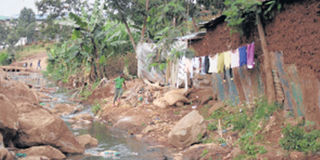Slum residents resign to fate as El Nino looms

A boy walks next to a house that is located dangerously close to the Mutoine River in Kibera. Residents have defied warnings to move to higher grounds. PHOTO | PETER OMBEDHA | NATION MEDIA GROUP
What you need to know:
- In the informal settlements where a majority of the residents live near river banks or abandoned quarries, the lurking danger appears to have been largely ignored.
- In May, 10 people died after the perimeter wall of the South B Mosque collapsed on shanties in Mukuru Fuata Nyayo slums at night. Another four people were swept away in Kayole and one in Ruaraka in June while dozens died of cholera broke out in Kibera.
For many citizens of Nairobi, the oncoming El Nino rains will mean a disruption of business activities and those commuting have to stay endless hours in traffic jams. In the slums however it will be yet another season of death, tears, pain, destruction, disease and sleepless nights.
The meteorology department has in the last few weeks been issuing warnings over possible destruction of infrastructure. Nairobi Governor Evans Kidero too issued a similar warning last week telling people living near rivers to move to higher ground.
In the informal settlements where a majority of the residents live near river banks or abandoned quarries, the lurking danger appears to have been largely ignored.
In Kibera the confluence between the Mutoine River and Ngong River in Kibera as they flow into the Nairobi Dam in the east turns into a raging flood plain that causes destruction to part of Gatwekera and Kisumu villages each rainy season.
Last week it was business as usual despite the residents admitting to the Sunday Nation that they are aware of the impending danger and destruction the rains will bring. Some said they can’t heed to warnings since they have nowhere else to go.
In May, dozens of houses were washed away at this spot which Jacob Opondo, a tailor said was the worst season in the 10 years he has lived there.
“We could not sleep for several nights. The noise alone that comes from the river as it rages makes you fear that you will be washed away if you sleep,” he recalled.
“But I am used to the rains. The El Nino will come, destroy a few houses but it won’t last forever and people will rebuild as they have always done,” he concludes.
His neighbour Evelyn Kizito rules out moving out from her house for fear it might be occupied by another person.
“Getting a house is difficult in Kibera. You move your things out even if it is for a few days and a new person will and occupy it,” she said.
“The landlords are only interested in money, whoever lives in the house or whether it gets destroyed by the rain is none of their problems so it is up to you to safeguard your tenancy,” she said.
During the last rainy season, Ms Kizito who has four children endured long nights of draining water from her house. It is a routine she has done for three years.
“There’s a pit latrine on the river bank nearby, and as the waters rose, raw sewage overflowed into the house and my two boys got diarrhoea,” she said.
“The government has just told people to move but no one is telling people where they should go to or how they will survive,” said Victoria Makove, another resident.
The National Disaster Operations Centre has said the expected rains will be above normal.
“The expected “above normal” rains will be 125 per cent more than Kenya gets during normal season. Such high amounts of rain will result in flash floods and high moisture levels, promoting the breeding of disease-causing organisms,” warned the Centre’s director Nathan Kigotho.
In May, 10 people died after the perimeter wall of the South B Mosque collapsed on shanties in Mukuru Fuata Nyayo slums at night. Another four people were swept away in Kayole and one in Ruaraka in June while dozens died of cholera broke out in Kibera. Across the city in Embakasi’s Mabatini slum, a four-year-old girl was electrocuted as she was playing.
It is a cycle that experts say is increasingly getting worse due to urbanisation and destruction of forest cover.
“During the rainy season, forests act as sponges, sucking up rainfall and controlling flows downstream, hence preventing floods,” said Dr Joseph Mutemi of the University of Nairobi’s Department of Meteorology.
“In urban areas, construction of concrete buildings is to blame for annual flooding in low-lying areas especially in slums,” he said.
All drainage systems in the city direct water out of the capital through two main channels - Nairobi and Mutoine rivers.
Nairobi River runs from Kileleshwa to Westlands and crosses the city centre at Globe Cinema Round About before leaving the city to join Athi River.
Mutoine River originates in Ngong Forest, runs through Kibera into Nairobi Dam which acts as a temporary reservoir before heading to Nairobi West and Industrial Area before leaving the city through Kayole to join Athi River.
Families have built houses just next to the rivers which flood heavily during the rainy season.




